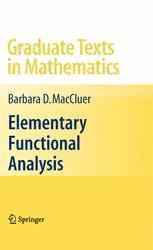
Elementary Functional Analysis PDF
Preview Elementary Functional Analysis
253 Graduate Texts in Mathematics EditorialBoard S.Axler K.A.Ribet GraduateTextsinMathematics Forothertitlespublishedinthisseries,goto http://www.springer.com/series/136 Barbara D. MacCluer Elementary Functional Analysis (cid:65)(cid:66)(cid:67) Barbara D. MacCluer Department of Mathematics University of Virginia P.O.Box 400137 Charlottesville VA 22904-4137 USA [email protected] EditorialBoard S.Axler K.A.Ribet MathematicsDepartment MathematicsDepartment SanFranciscoStateUniversity UniversityofCalifornia,Berkeley SanFrancisco,CA94132 Berkeley,CA94720-3840 USA USA [email protected] [email protected] ISBN:978-0-387-85528-8 e-ISBN:978-0-387-85529-5 DOI:10.1007/978-0-387-85529-5 LibraryofCongressControlNumber:2008937759 Mathematics Subject Classification (2000): 46-01, 47-01 (cid:176)c SpringerScience+BusinessMedia,LLC 2009 Allrightsreserved.Thisworkmaynotbetranslatedorcopiedinwholeorinpartwithoutthewritten permissionofthepublisher(SpringerScience+BusinessMedia,LLC,233SpringStreet,NewYork,NY 10013,USA),exceptforbriefexcerptsinconnectionwithreviewsorscholarlyanalysis.Useinconnection withanyformofinformationstorageandretrieval,electronicadaptation,computersoftware,orbysimilar ordissimilarmethodologynowknownorhereafterdevelopedisforbidden. Theuseinthispublicationoftradenames,trademarks,servicemarks,andsimilarterms,eveniftheyare notidentifiedassuch,isnottobetakenasanexpressionofopinionastowhetherornottheyaresubject toproprietaryrights. Printedonacid-freepaper springer.com ToTom,Josh,andDavid Preface Functionalanalysisaroseintheearlytwentiethcenturyand gradually,conqueringonestrongholdafteranother,becamea nearlyuniversalmathematicaldoctrine,notmerelyanewarea ofmathematics,butanewmathematicalworldview.Its appearancewastheinevitableconsequenceoftheevolutionof allofnineteenth-centurymathematics,inparticularclassical analysisandmathematicalphysics.Itsoriginalbasiswas formedbyCantor’stheoryofsetsandlinearalgebra.Its existenceansweredthequestionofhowtostategeneral principlesofabroadlyinterpretedanalysisinawaysuitablefor themostdiversesituations. A.M.Vershik([45],p.438). This text evolved from the content of a one semester introductory course in func- tionalanalysisthatIhavetaughtanumberoftimessince1996attheUniversityof Virginia.Mystudentshaveincludedfirstandsecondyeargraduatestudentsprepar- ing for thesis work in analysis, algebra, or topology, graduate students in various departmentsintheSchoolofEngineeringandAppliedScience,andseveralunder- graduate mathematics or physics majors. After a first draft of the manuscript was completed, it was also used for an independent reading course for several under- graduatespreparingforgraduateschool. Whilethisbookisshort,comparativelyspeaking,itdoesnotaccomplishitaims throughbrevity.Argumentsaregenerallypresentedindetail,andinfactIhavetried to firmly keep in mind the reader who may be learning the material on his or her ownwithoutthebenefitofaformalcourseorinstructor.Sincefunctionalanalysisis ahugefield,IhavehadtomakemanyomissionswithregardtothetopicsIpresent. Thesechoicesrepresent,ofcourse,myownpreferences,butalsomydesiretostart withthebasicsandstilltravelapaththroughsomesignificantpartsofmodernfunc- tionalanalysis. The prerequisites for this book include undergraduate courses in real analysis, linearalgebra,andbasicpointsettopology(say,inmetricspaces).Amodicumof complex analysis is used in a few examples and exercises, and in the proofs of a few results in Chapter 5; in a pinch it is not an essential prerequisite for a student willing to bypass those parts (or take them on faith). With respect to real analysis a good undergraduate level course is essential. Beyond this some familiarity with measure theory and the Lebesgue integral is desirable, but not essential. Save for thelastchapter,mostoftheuseofmeasuretheoryandLebesgueintegrationoccurs in limited ways—primarily in examples. An Appendix provides a summary and expositorydiscussionofallthatisneededhere.Iencourageanyprospectivereader who may feel shaky with these desirable but not essential prerequisites not to be dauntedbythem.OnthebasisofmyexperiencesteachingthismaterialIhavefound that students with no prior exposure to complex analysis or measure theory and Lebesgueintegrationcanneverthelesshaveasuccessfulexperiencewiththetopics presentedhere. vii viii Preface I have woven a certain amount of historical commentary into the text; this re- flectsmybeliefthatsomeunderstandingofthehistoricaldevelopmentofanyfield in mathematics both deepens and enlivens one’s appreciation of the subject. The history of functional analysis is filled with interesting characters, many of whom livedandworkedduringturbulenttimesinthetwentiethcentury. Eachchapterconcludeswithanextensivecollectionofexercises.Thepurposeof theexercisesistoenablethereadertobecomecomfortablewiththeideasinthetext; tomakethemhisorherown.Whilemostarethereforecloselytiedtothematerial beingdiscussed,anoccasionalexerciseisintendedtoprovideaninitialsteporsteps towardsatopicnotdiscussedinthetext,ortopointthewayforfurtherexploration. Inanycase,allareintendedtobeeminentlydoablebyastudentandwhenadvisable areaccompaniedbyahint. I would like to express my great appreciation to several friends and colleagues who provided advice and encouragement during the writing of this book. Sheldon Axler, Tom Goebeler, Christopher Hammond, and Bill Ross read substantial por- tionsofthemanuscriptandprovidedmanyhelpfulcomments,aswellassuggestions forexercises.LarryThomasgaveusefulfeedbackontheAppendix.MarkSpencerat Springerprovidedvaluableeditorialassistance.JulieRiddlebergerhelpedwiththe illustrations, and patiently answered many TEX questions. I thank Tom Kriete for hisenthusiasticsupportandencouragementthroughoutallstagesofthiswork.And finallyIthankthestudentsintheFunctionalAnalysiscourseItaughtattheUniver- sity of Virginia in each of the last several years. It was their enthusiastic response tothiscoursethatinitiallygotmethinkingaboutwritingafunctionalanalysistext, andhelpedmerefinemyideasofwhatthistextshouldlooklike. Charlottesville,Virginia BarbaraD.MacCluer July2008 Contents Preface............................................................ vii 1 HilbertSpacePreliminaries ..................................... 1 1.1 NormedLinearSpaces ...................................... 2 1.2 Orthogonality.............................................. 10 1.3 HilbertSpaceGeometry ..................................... 12 1.4 LinearFunctionals.......................................... 15 1.5 OrthonormalBases ......................................... 19 1.6 Exercises ................................................. 23 2 OperatorTheoryBasics......................................... 31 2.1 BoundedLinearOperators ................................... 31 2.2 AdjointsofHilbertSpaceOperators ........................... 34 2.3 AdjointsofBanachSpaceOperators........................... 41 2.4 Exercises ................................................. 43 3 TheBigThree ................................................. 49 3.1 TheHahn–BanachTheorem.................................. 50 3.2 PrincipleofUniformBoundedness ............................ 55 3.3 OpenMappingandClosedGraphTheorems .................... 61 3.4 QuotientSpaces............................................ 66 3.5 BanachandtheScottishCafe´................................. 67 3.6 Exercises ................................................. 68 4 CompactOperators ............................................ 77 4.1 Finite-DimensionalSpaces................................... 77 4.2 CompactOperators ......................................... 80 4.3 APreliminarySpectralTheorem.............................. 87 4.4 TheInvariantSubspaceProblem .............................. 94 4.5 IntroductiontotheSpectrum ................................. 96 4.6 TheFredholmAlternative ................................... 99 4.7 Exercises .................................................101 ix x Contents ∗ 5 BanachandC -Algebras ........................................107 5.1 FirstExamples.............................................108 5.2 ResultsonSpectra..........................................110 5.3 IdealsandHomomorphisms..................................120 5.4 CommutativeBanachAlgebras ...............................124 5.5 WeakTopologies...........................................127 5.6 TheGelfandTransform .....................................132 5.7 TheContinuousFunctionalCalculus ..........................140 5.8 FredholmOperators ........................................143 5.9 Exercises .................................................146 6 TheSpectralTheorem ..........................................157 6.1 NormalOperatorsAreMultiplicationOperators .................157 6.2 SpectralMeasures ..........................................165 6.3 Exercises .................................................183 AppendixA: RealAnalysisTopics ...................................187 A.1 Measures .................................................187 A.2 Integration ................................................190 A.3 Lp Spaces .................................................196 A.4 TheStone–WeierstrassTheorem ..............................197 A.5 PositiveLinearFunctionalsonC(X)...........................198 References.........................................................201 Index .............................................................203 Chapter 1 Hilbert Space Preliminaries Itseemstomenotuselesstoindicateinterestinastudyofsets composedoffunctions.... J.Hadamard,InternationalCongressofMathematicians, Zu˜rich,1897. Functional analysis developed in the late nineteenth and early twentieth centuries, duringaperiodinwhichtherewasageneralinterestinabstraction,axiomatization, andunificationacrossallfieldsofmathematics.Thisunificationmeantthatobjects thatbehavedaccordingtoacommonsetofruleswereviewedas“thesame,”even if they consisted of rather different elements. A core idea in functional analysis is to treat functions as “points” or “elements” in some sort of abstract space, so that insteadofworkingwithindividualfunctions(thetraditioninclassicalanalysis),we dealwithfunctionsaspointsinaspaceendowedwithsomekindofoverallstructure. Thestructureofthespaceitselfisemphasizedoverpropertiesofindividualelements inthespace.Thisviewpoint,accompaniedbyanaxiomatizationofthenewspaces tobeconsidered,wasanintegralstepintheprocessoftransferringfamiliarconcepts in finite-dimensional Euclidean space to (typically infinite-dimensional) “function spaces.” Whileimportantcontributionstothebeginningsoffunctionalanalysisweremade byindividualsofvariousnationalities,themostreadilyidentifiableschoolsofwork in the early history of the subject were in France, Italy, and Germany. In France, oneofthenotablecontributorstotheinitialdevelopmentoffunctionalanalysiswas MauriceFre´chet,whose1906doctoraldissertationisalandmarkpaperinthesub- ject. In this work, which was extremely influential in both functional analysis and pointsettopology,Fre´chetbeganthestudyofabstractspacesoffunctions.Inpartic- ular,hedefinedthenotionofametricspace(whichhecalled“(E)”spaces,fromthe French “e´cart” meaning distance), and included a discussion of examples of met- ricspaceswherethepointsinthespacewerefunctions.InFre´chet’sworkonecan clearlyseetheinfluenceofhisadvisorJacquesHadamard.InanaddresstotheInter- nationalCongressofMathematiciansin1897,Hadamardproposedastudyofwhat wouldnowbetermedset-theoretictopology.Aquotefromthisaddressintroduces thischapter;hisstudentFre´chettookupthechallengeputforththere. Inthischapterwedescribethebasickindsofspaceswhichwillinterestus,witha particularemphasisonHilbertspaces,whicharerichingeometricstructure.Insim- plestterms,theideabehindaHilbertspaceistogeneralize thefamiliarEuclidean B.D.MacCluer,ElementaryFunctionalAnalysis,DOI10.1007/978-0-387-85529-5 1, 1 (cid:1)c SpringerScience+BusinessMedia,LLC2009
